Selling a cigarette lighter on eBay?
Think about these tips to become a better seller and get more money for your lighter - while doing a favor for your potential buyers.
More Information = More $$$
No one likes buying the proverbial pig in the poke. Would YOU pay more for something if you have a very good idea of what to expect? And expect to pay less if you're just guessing at what you may be getting? Of course!
Now, you may not want to take matters to the limit by getting into everything about a lighter - it simply may not be worthwhile. But, if you start at the top with the basics and move as far down the list as it comfortable for you and worthwhile for the sale, you'll get a better price from your lighters!
No Excuses!
The old story "I don't smoke and I don't know anything about lighters" is usually a poor reflection on an adult's intelligence. A lighter is one of the most ubiquitous machines around and it really stretches the imagination to believe anyone over 8 years of age can't figure out how to operate one. Now, there are some that are a bit complex and take a little thought to figure out how to work them - but these are very, very rare. Please don't insult yourself and the buyer's intelligence with this line! If you really don't know, all of the basic information to make an intelligent description of your lighter is on this page.
Shipping
This is my pet peeve about many sellers: Shipping is unreasonable high! Generally speaking there is no reason for shipping Priority Mail (we're speaking of lighters, now). Most pocket lighters can be shipped First Class Mail for about $2.00 including a Delivery Confirmation Number. That takes about one day longer to arrive; occasionally two days. The less a buyer has to spend on postage, the more they can spend on the lighter! Even if you need to add on something for packing materials, you can still ship for $3.50 or less and cover your costs nicely and give the buyer a reasonable rate. I have purchased as many as 150 lighters in a month on eBay. A couple of dollars difference in the shipping on each one adds up to quite a bit! I have frequently gotten lighters from Great Britain that shipped air post cheaper than lighters from a couple of states away from where I live; there is no reason for that!
Good Pictures
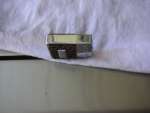 A picture of a lighter sitting on a sofa cushion taken in bad light from 4 feet away doesn't help much. If you can't tell from the picture what you are selling and how it looks, how can anyone else? Is your picture too blurry to make anything out? Are you so far from a small subject that it just looks like something sitting there and you wouldn't know what it was if you hadn't just taken the picture? Did you use a flash and get so much glare or reflection that you can really see anything? Is the subject too dark to tell anything about it? Would you want to buy something that was so obscure? Even if you did, you would have to pay less for it because you can't tell what you're getting, right? Do your eBay pictures look like this sample shown to the right? Would you want to buy this lighter? Click on the picture to see what the eBay enlargement looked like! A picture of a lighter sitting on a sofa cushion taken in bad light from 4 feet away doesn't help much. If you can't tell from the picture what you are selling and how it looks, how can anyone else? Is your picture too blurry to make anything out? Are you so far from a small subject that it just looks like something sitting there and you wouldn't know what it was if you hadn't just taken the picture? Did you use a flash and get so much glare or reflection that you can really see anything? Is the subject too dark to tell anything about it? Would you want to buy something that was so obscure? Even if you did, you would have to pay less for it because you can't tell what you're getting, right? Do your eBay pictures look like this sample shown to the right? Would you want to buy this lighter? Click on the picture to see what the eBay enlargement looked like!
What Kind Of Lighter Are You Selling
FUEL: Generally, lighters are one of two fuel types: butane gas -or- petrol or lighter fluid as the fuel source. There are exceptions, but they are very infrequent. So, how do you know which fuel a lighter uses? Look where the flame would come out. If there is a wick, it is petrol (a.k.a. lighter fluid). If there is a gas nozzle, it is butane. It is also possible the wick is missing from a petrol lighter - there will be an empty hole where the wick should be - it is much larger than the tiny hole a gas nozzle would have.
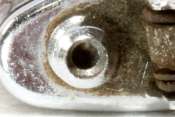 |
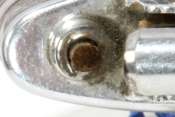 |
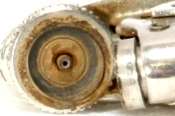 |
| No Wick |
Wick |
Nozzle |
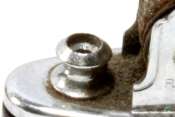 |
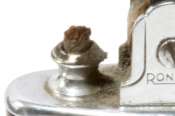 |
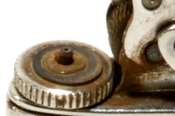 |
| Some gas nozzles have a flame adjuster around them; many don't. |
IGNITION: Generally, there are three ignition types: Flint - Piezoelectric (a.k.a. Electro Quartz) - Electric. Again, there are infrequent exceptions. There are very rare exceptions, but almost always a petrol lighter will use a flint for ignition where the spark from the flint ignites the lighter fluid. Some butane lighters use a piezoelectric system for ignition - this requires no flint or battery; when it's dead, it's dead as there is nothing that can economically be replaced as would be the case with a flint or battery. You can tell if the ignition is piezoelectric by looking at the area around the gas nozzle as you activate the lighter. If it is an operational piezoelectric lighter, you'll see a brief, blue electrical spark. Gas lighters also very frequently use a flint to generate the spark to ignite the gas. Rarely lighters use a battery to generate a spark for ignition - in some cases even using a heating coil to ignite the fuel; while these can be seen in petrol lighters, they are more common in gas lighters.
If you see a rough wheel that turns when the lighter is activated, this is the spark wheel. This rubs against the flint to produce a spark. This is a certain sign of a flint ignition system in any lighter.
How Operational Is The Lighter
Well, first you just push the button that activates the lighter. If it happens to light up, it's a working lighter and definitely worth more. If it gives a good spark, that's a great start and for a flint and petrol lighter, just about as good as having it light up.
So, it didn't light... Did the mechanism seem to be working well enough that given an ignition source and fuel you believe it would light? This is particularly important for flint and petrol lighters because if the mechanism seems operational, fuel can be added and the flint fixed and it will likely work. For gas lighters, it's a different story; unless they work, it has to be assumed they won't work due to a leaky gas tank or bad valves. Even if you get one working, unless you have filled it with fuel and let it set for a few days and then tried to ignite it again, there is no way to quickly and easily tell if there is a leak in the tank or valves and buyers will take this into consideration.
Lighter Condition
Brassing: If the lighter is plated, is there any brassing (the chrome or other plating is coming off and showing the brass below it)?
Scratches / Chips: Are there scratches to the lighter finish and.or chips if part of the finish is pained? To what degree?
Dents: Any dings and dents in the lighter case?
Missing Parts: As you look the lighter over, so you see empty holes where a screw should be? Something else gone that should be there or just doesn't look right?
Don't lie about the age!
OK, often they aren't "lies" so much as ignorance. Just because a lighter looks old doesn't mean it was in World War 1. The vast majority of the "WW1 Trench Lighter" items I have seen are the slide lighters that weren't made until in the 1930s in almost all cases; well after WW1, but certainly prominent in WW2.
If it's an aluminum block lighter, it is most likely from the mid-1940s to early 1950s. If it is steel, it could well date to World War 2, if there are other indications of that age, as the shortage of brass meant many (of the few made) lighters were made from steel.
Using a patent date to determine the age? A lighter can't possibly be older than the NEWEST patent date; it definitely isn't as old as the oldest one when there is more than one.
|

